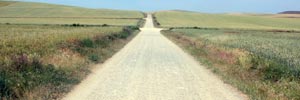
Walking across France… days of color that never ends…
Weights & Measures – part 2
Body or “Skin” Weight
Body weight or “skin” weight is simply the naked weight of a person. Just shed your clothes and hop on a scale and you have it. For ultralighters, it’s one of the standard figures used to calculate the total weight of everything that’s planning to walk down the trail. The more you weigh, the more energy it takes for you to travel a given distance. That translates into calories, which means fuel for you (food), and possibly, fuel to cook it (alcohol, gas, etc.). All fuel weighs something.
Body weight is an important factor in fitness, and creates the single heaviest load on your joints. Depending on the speed and slope that you’re walking, every pound of weight above the knees, exerts 3 to 5 pounds of force on your knees. Anyone with arthritis below the waist should be especially mindful. Even a 5 or 10 pound reduction in body weight is beneficial for helping to ease these effects. If you’re feeling a little portly and are planning a long walk, get out and start training today.
One of the common health benefits of long-distance walking is gradual weight loss. On my first walk across France and Spain, no matter how much butter, pastry, sausage, cheese, pâte, wine, and beer I ingested (as part of a diverse and balanced diet!), I still lost about 30 pounds over the course of 3 months. I generally stopped in a large town or city for a day of rest and sightseeing about once a week, and sometimes ate four, or even five meals on those recovery days, but still continued shedding weight. Some hikers even bulk up a couple of pre-departure kilos to provide an extra store of energy for the relentless exertion of the trail.
“Skin-Out” Weight
You often see this succinct and jargon on ultralight backpacking websites. “Skin-Out” Weight is the total weight of your entire load – everything worn or carried, on your person, in pockets or pack, including clothes, shoes, hat, backpack, food, fuel, water – everything. Add in you and your “skin” (body) weight, and you’re ready to head out the door — unless you need to lose a little weight, on one side of your skin or the other…
Deadweight or Static Weight
Deadweight is weight of things you have with you from beginning to end, over the full distance of your walk. You have them (or don’t) for the duration. Major components of static weight are backpack, shoes, sleeping bag, shelter, containers, camera, etc. It’s not a bad thing, it’s just a fact, and worth keeping in mind as you assemble your gear and wardrobe.
Some deadweight objects are among the heaviest items, and so deserve careful consideration. Substantial weight savings can be achieved by making smart choices, and where possible, weight-saving modifications.
A 3-pound backpack is 20% of a 15-pound total carry weight goal. What you really want and need is what’s in the pack, so the less the pack itself weighs, the more stuff you can haul while still achieving the same combined weight. There are many options available, and you should have no problem finding a pack well under 2 pounds (and considerably less from there) suitable for multi-month trekking. On my 2009 walk across France and Spain, I carried a Gossamer Gear® Murmur™ backpack, which weighed 185 grams (6.5 ounces). It proved more than up to the task, and was about 5% of my 8-pound base pack weight.




